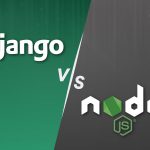Top 10 Reasons Why Django is Best Framework for Web Development

As the web development market continues to soar – predicted to reach $89+ billion by 2027 from $60.7 billion in 2022 – it makes it perfectly clear that web applications will be an unequivocal choice for enterprises as they are today.
In the endeavor to build first-rate website applications, a challenge is emerging – discerning the right web framework when there is an ever-expanding array of options. Written in Python, Django is a great tool for developing web apps. As the options keep flooding the list, it maintains its position as the framework that web developers can pick up for its performance, without a shadow of a doubt.
Django has carved its niche for intricate website projects. It is the second most used Python web framework after Flask, and even if Flask is the first most used, Django surpasses it when it comes to large-scale projects. The former is more suitable for simpler requirements, on the other hand, the latter offers all-round web development capabilities.
To get our point across, we figure out why Django should be chosen. We explain its feasibility in web software development projects by offering you a curated list of the top reasons for using Django for web development.
Why is Django the best framework for Web Development
Offering best-in-class features, Python Django has made a compelling case as the best web development framework. As the reasons abound for the framework’s vast use, we bring the top 10 reasons to choose Django for developing web apps.
High-Level Abstraction for Development Tasks
Django comes with the ability to simplify and automate complex tasks in web development. This it achieves through a combination of pre-built components, and conventions.
One prominent example of the abstraction is Django’s Object-Relational Mapping (ORM) system. It allows developers to interact with databases using Python code, rather than writing SQL queries directly. For instance, creating a new table in a database can be accomplished with a few lines of Python code, as:
class Product(models.Model):
name = models.CharField(max_length=100)
price = models.DecimalField(max_digits=10, decimal_places=2)
This type of abstraction shields developers from low-level database operations, making it easier to focus on application logic.
Additionally, Django’s URL routing and view handling provide another layer of abstraction. Defining routes and handling HTTP requests is straightforward, and developers can concentrate on building the core functionality of the web application with ease. Here is a demonstration of the same.
# urls.py
from django.urls import path
from . import views
urlpatterns = [
path(‘products/’, views.product_list, name=’product_list’),
path(‘products/<int:id>/’, views.product_detail, name=’product_detail’),
]
The above code maps URLs to views, making it easy to navigate the application.
In real-life projects, such abstractions significantly accelerate the development process. For instance, a team building an e-commerce site can leverage Django’s high-level abstractions to rapidly create and manage product listings, handle user authentication, and interact with a database. Armed with these capabilities, they can focus on developing unique features and bettering user experience.
Comprehensive Built-in Features
Django is distinguished by its variety of built-in features. Developers can define data models in Python code, and Django automatically handles the creation and management of the corresponding database tables. Simplifying database interactions, it allows developers to focus on application logic rather than SQL queries. For instance, defining a model for a blog post in the Django framework is a straightforward task, as these lines showcase:
class Post(models.Model):
title = models.CharField(max_length=200)
content = models.TextField()
pub_date = models.DateTimeField(‘date published’)
The Django framework includes an extensive pre-built administrative interface that allows for easy content management without the need to create a custom one. It automatically generates an admin interface based on the defined models. This is particularly useful for content-heavy websites where administrators need to manage a large amount of data.
Django is a Python framework that comes with an authentication system, which secures user authentication, authorization, and password management out of the box. Developers can easily integrate user registration, login, and password reset functionalities without writing extensive code.
Furthermore, Django offers a powerful URL routing mechanism, making the URL patterns clean and organized. As a result, developers can manage different views and templates within a web application in a hassle-free manner. For example, a URL pattern in Django might look like this:
path(‘posts/<int:post_id>/’, views.post_detail, name=’post_detail’)
Any-extent Scalability
Scalability is important to any application as the load that an application handles continually increases. When adopting a tool or technology for building applications, scalability is thus given high importance. 74% of business leaders believe that it is an important criterion for evaluating a new technology for their projects.
Django with its rich characteristics is best suited to build scalable web applications. It offers support for caching mechanisms and easily integrates with load-balancing solutions, effectively distributing resources and preventing a server from becoming overwhelmed. Its ability to handle large-scale applications with changing data sets over time makes it an excellent choice for startups to enterprise-level companies across various industries.
The recent introduction of asynchronous support has bolstered the web framework’s ability to handle concurrent requests, a vital feature for real-time applications. Moreover, with Django’s modular architecture, developers can build reusable components, which is important to build scalable applications.
Enterprises, small and large, use the Django framework to successfully scale applications. Instagram reported a whopping 2 billion monthly active users in 2022. Given the enormous volume of data and user interactions it manages, including likes, shares, and more, the social media platform faces the formidable challenge of handling an immense workload. Yet, as it uses the Django framework, it is well-equipped to meet the and can focus on bringing improvements to UI and UX.
Compliance with Web Standards
Django’s ability to adhere to the industry-accepted practices and protocols stems from its robust architecture. As a web framework, it enforces adherence to HTML, CSS, and JavaScript, providing a structured approach to handling these technologies.
The Model-View-Controller (MVC) architectural pattern, which separates the application logic from the presentation layer, is one core aspect of Django. Promoting organized development, this feature carries out the development according to software engineering principles. It is based on DRY (Don’t Repeat Yourself) and KISS (Keep It Simple, Stupid) principles, which are essential for creating clean and maintainable code.
Django undergoes regular updates that incorporate security patches, and can consistently maintain high standards by staying current. So, even if you’re working with an older version of the framework, it receives new patches to ensure ongoing security. The ability to strictly adhere to development and security upgrades is one important reason why Django is a preferred framework for building web applications.
MVC (Model-View-Controller) architecture
In terms of architecture, Django follows an MVC architecture is a design pattern that separates an application into three interconnected components: Models, Views, and Controllers. This separation of concerns has become a prime requirement in modern web development projects for cleaner, more organized code.
In Django, the Model represents the data structure and logic of the application. It defines the data schema and interacts with the database. Isolation of models gives developers the capability to focus on the data-related aspects without worrying about the user interface or business logic.
The View handles the presentation layer, responsible for rendering the user interface. It takes data from the Model and renders it into a format that can be displayed in a web browser. With its separation, the changes in the presentation do not affect the underlying data or application logic.
Lastly, the Controller, in Django’s case, is handled by the framework itself and it manages the flow of data between the Model and the View, handling user input and triggering appropriate actions. Working as an autonomous unit, it removes the need for developers to manually implement any functionality.
Active Community and Extensive Resources
The popularity of Django has led to the building of a vibrant and engaged community which has been contributing significantly to its success. As of October 2023, it has community support of around 118k members on Reddit, 73.8K stars, and 30.3K forks on GitHub. There is a large pool of experienced developers and enthusiasts actively participating in discussions, sharing knowledge, and helping each other overcome challenges in development.
The vast Django community ensures a constant influx of new tutorials, articles, and best practices. This wealth of resources is invaluable for both beginners and experienced developers looking to enhance their skills or tackle specific challenges. It allows developers to quickly find solutions to their problems, some of which bring unique technical challenges.
Django also benefits from a vast ecosystem of third-party packages. These pre-built modules cover a wide range of functionalities, from authentication and authorization to database management and deployment. The extensive library of packages accelerates application development by allowing developers to leverage existing solutions rather than reinventing the wheel.
The presence of well-maintained official documentation is another crucial aspect of Django. It serves as a comprehensive reference guide, making it easier for developers to learn Django and navigate its various features efficiently.
Superb Security Standards
In web development, security is paramount because web applications constantly interact with the external environment, which includes users, databases, and other services. Vulnerabilities in security can lead to data breaches, unauthorized access, and other malicious activities.
Django addresses these concerns through a range of features. One key aspect is its robust authentication system, which ensures that only authorized users can access specific parts of a web app. It provides a secure password storage mechanism and offers options for multi-factor authentication, adding an extra layer of protection.
Another critical security measure in Django is its protection against common web vulnerabilities like Cross-Site Scripting (XSS) and SQL injection attacks. Django’s templating engine automatically escapes content, preventing malicious scripts from being executed in a user’s browser. Additionally, Django’s Object-Relational Mapping (ORM) system prevents direct SQL queries, mitigating the risk of SQL injection attacks.
Django also incorporates a powerful middleware system that allows developers to apply security-related functions globally to a web application. This is characterized by features like clickjacking protection, Content Security Policy (CSP) support, and secure HTTP headers.
Last but not the least, Django encourages secure coding practices by providing detailed documentation on how to write secure code and avoid common pitfalls.
Also Read: Top Django Security Best Practices To Know
All-platform Compatibility
Web applications built with Django run seamlessly on various operating systems, including Windows, macOS, and various Linux distributions. This versatility is a key reason why developers from a professional web application development services provider heavily prefer Django for web development.
Since Django inherits its capabilities from Python, the applications built using it can be developed on one platform and easily deployed on another without significant modification. Whether a developer prefers Windows for its user-friendly interface, macOS for its sleek design, or Linux distribution for its robustness and customization options, Django accommodates all preferences.
Moreover, Django’s architecture is designed to abstract away low-level system-specific functionalities. With these capabilities, developers can focus on building applications rather than worrying about platform-specific nuances, which is why Django applications perform consistently across different environments.
Providing a comprehensive set of tools and libraries that are agnostic to the underlying operating system, Django streamlines the process of handling databases, managing user authentication, handling HTTP requests and responses, and more.
SEO-Friendly URL Structure and Sitemap Generation
Python Django structures URLs in a clear, human-readable format, which is essential from the perspective of search engine optimization (SEO). Unlike cryptic query strings, Django lets developers define URL patterns in the urls.py file. For instance, instead of a convoluted URL like www.example.com/product?id=123, Django allows for a much cleaner and intuitive format like www.example.com/product/123/, which aids search engines in understanding the content.
Also, Django’s URL routing system allows for powerful pattern matching. You can define dynamic URLs to handle various parameters. In the case of a blog, a URL pattern like www.example.com/blog/post/<int:post_id>/ can be used to dynamically fetch and display different blog posts based on their unique IDs.
Next, Django’s sitemap generation capability automatically generates XML sitemaps that list all the important pages on a website, along with metadata like last modification dates and priority levels. As a result, search engines like Google can efficiently crawl and index the site’s content. For instance, a Django-based eCommerce site can dynamically generate a sitemap that includes product listings, categories, and other relevant pages.
Abundance of Reusable Tools
One of the hallmark features of Django is its extensive collection of pre-built modules and libraries, known as “apps”. These apps encapsulate specific functionalities, such as authentication, content management, and form handling, which developers can integrate into their projects on demand. For instance, the built-in authentication system provides robust user authentication and authorization, complete with password reset functionalities, without the need to develop these features from scratch.
The template system that Django provides comes in handy for building dynamic and reusable HTML templates. These templates can be easily customized and reused across different pages of a web application. Moreover, Django’s package management system, another great reusability feature, enabled by tools like pip, allows developers to easily integrate third-party packages and libraries into their projects.
Also, Django’s robust form-handling capabilities simplify the process of collecting and validating user input. The built-in form handling system automatically generates HTML forms based on Python classes, handling tasks like data validation and error handling.
Implement Python Django Framework Using Finoit’s Expertise
Django shines as a powerful front-end framework for creating dynamic and interactive user experiences, but it is essential to complement it with a strong development capability that usually an established Django company can offer.
The availability of skilled Django developers from Finoit can alleviate any concerns about web application development. With our well-rounded team, you can confidently embark on your projects, knowing that you have the expertise needed to succeed.
If you want to hire Django experts, we have a ready staff of Python developers who can help you with surge capacity and long-term development needs.

